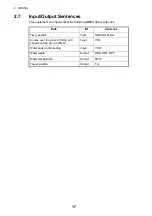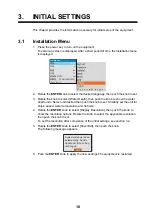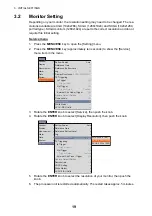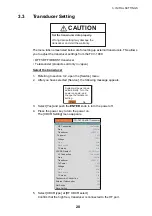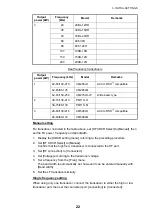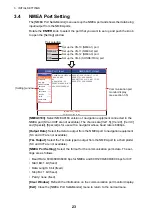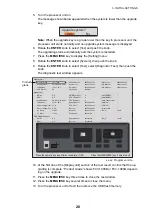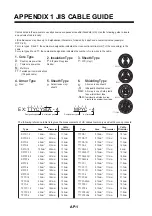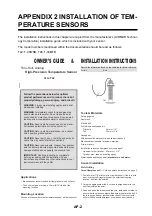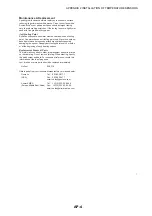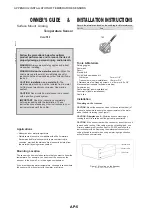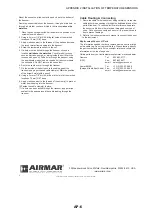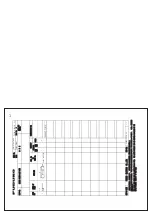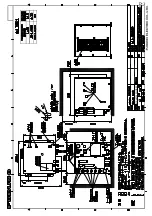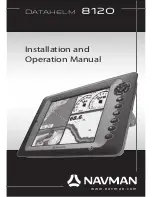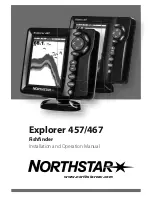
APPENDIX 2 INSTALLATION OF TEMPERATURE SENSORS
AP-3
Bedding
CAUTION
: Be sure all surfaces to be bedded are clean and dry.
1. Remove the hull nut (see Figure 1).
2. Apply a 2 mm (1/16") thick layer of marine sealant around the
flange of the sensor that will contact the hull and up the stem.
The sealant must extend 6mm (1/4") higher than the combined
thickness of the hull and the hull nut. This will ensure that there
is marine sealant in the threads to seal the hull and hold the hull
nut securely in place.
3. Apply a 2 mm (1/16") thick layer of marine sealant to the flange
of the hull nut that will contact the hull.
Insta
ll
ing
1. From outside the hull, thread the cable through the mounting
hole.
2. Push the sensor into the mounting hole using a twisting motion
to squeeze out excess marine sealant (see Figure 1).
3. From inside the hull, slide the hull nut onto the cable. Screw the
hull nut in place. Tighten it with slip-joint pliers.
Cored fiberglass hull
—Do not over tighten, crushing the hull.
Wood hull
—Allow for the wood to swell before tightening.
4. Remove any excess marine sealant on the outside of the hull to
ensure smooth water flow over the sensor.
Checking for Leaks
When the boat is placed in the water,
immediately
check around
the thru-hull sensor for leaks. Note that very small leaks may not
be readily observed. Do not to leave the boat in the water for more
than 3 hours before checking it again. If there is a small leak,
there may be considerable bilge water accumulation after 24
hours. If a leak is observed, repeat “Bedding” and “Installing”
immediately
(see page 2).
Cable Routing & Connecting
CAUTION
: If the sensor came with a connector, do not remove it
to ease cable routing. If the cable must be cut and spliced, use
Airmar’s splash-proof Junction Box No. 33-035 and follow the
instructions supplied. Removing the waterproof connector or
cutting the cable, except when using a water-tight junction box,
will void the sensor warranty.
1. Route the cable to the instrument being careful not to tear the
cable jacket when passing it through the bulkhead(s) and other
parts of the boat. Use grommet(s) to prevent chafing. To reduce
electrical interference, separate the transducer cable from other
electrical wiring and the engine. Coil any excess cable and
secure it in place with cable ties to prevent damage.
2. Refer to the instrument owner’s manual to connect the
transducer to the instrument.
Installation in a Cored Fiberglass Hull
The core (wood or foam) must be cut and sealed carefully. The
core must be protected from water seepage, and the hull must be
reinforced to prevent it from crushing under the hull nut allowing
the sensor to become loose.
CAUTION
: Completely seal the hull to prevent water seepage into
the core.
1. Drill a 3mm or 1/8" pilot hole from inside the hull. If there is a rib,
strut, or other hull irregularity near the selected mounting
location, drill from the outside. (If the hole is drilled in the wrong
location, drill a second hole in a better location. Apply masking
tape to the outside of the hull over the incorrect hole and fill it
with epoxy.)
2. Using the 21mm or 7/8" drill bit, cut a hole from outside the hull
through the
outer
skin only (see Figure 2).
3. From inside the hull using the 30mm or 1-1/4" hole saw, cut
through the
inner
skin and most of the core. The core material
can be very soft. Apply only light pressure to the hole saw after
cutting through the inner skin to avoid accidentally cutting the
outer
skin.
4. Remove the plug of core material so the
inside
of the outer skin
and the inner core of the hull is fully exposed. Clean and sand
the inner skin, core, and the outer skin around the hole.
5. Coat a hollow or solid cylinder of the correct diameter with wax
and tape it in place. Fill the gap between the cylinder and hull
with casting epoxy. After the epoxy has set, remove the
cylinder.
6. Sand and clean the area around the hole, inside and outside, to
ensure that the sealant will adhere properly to the hull. If there is
any petroleum residue inside the hull, remove it with either mild
household detergent or a weak solvent (alcohol) before sanding.
7. Proceed with “Bedding” and “Installing” (see page 2).
2
Figure 2. Preparing a cored fiberglass hull
inner skin
core
outer skin
solid or hollow cylinder
pour in
casting
epoxy
9-12 mm
(3/8-1/2")
larger than the
hole through the
hull’s outer skin
hull thickness
Figure 1. Bedding and installing
hull nut
hull
bedding
Copyright © 2005 - 2010 Airmar Technology Corp.
Copyright © 2005 Airmar Technology Corp.
Содержание FCV-1900/B/G
Страница 46: ...D 1 14 Apr 2015 H MAKI...
Страница 47: ...D 2 15 Apr 2015 H MAKI...
Страница 48: ...D 3 15 Jan 2015 H MAKI...
Страница 50: ......
Страница 51: ......

